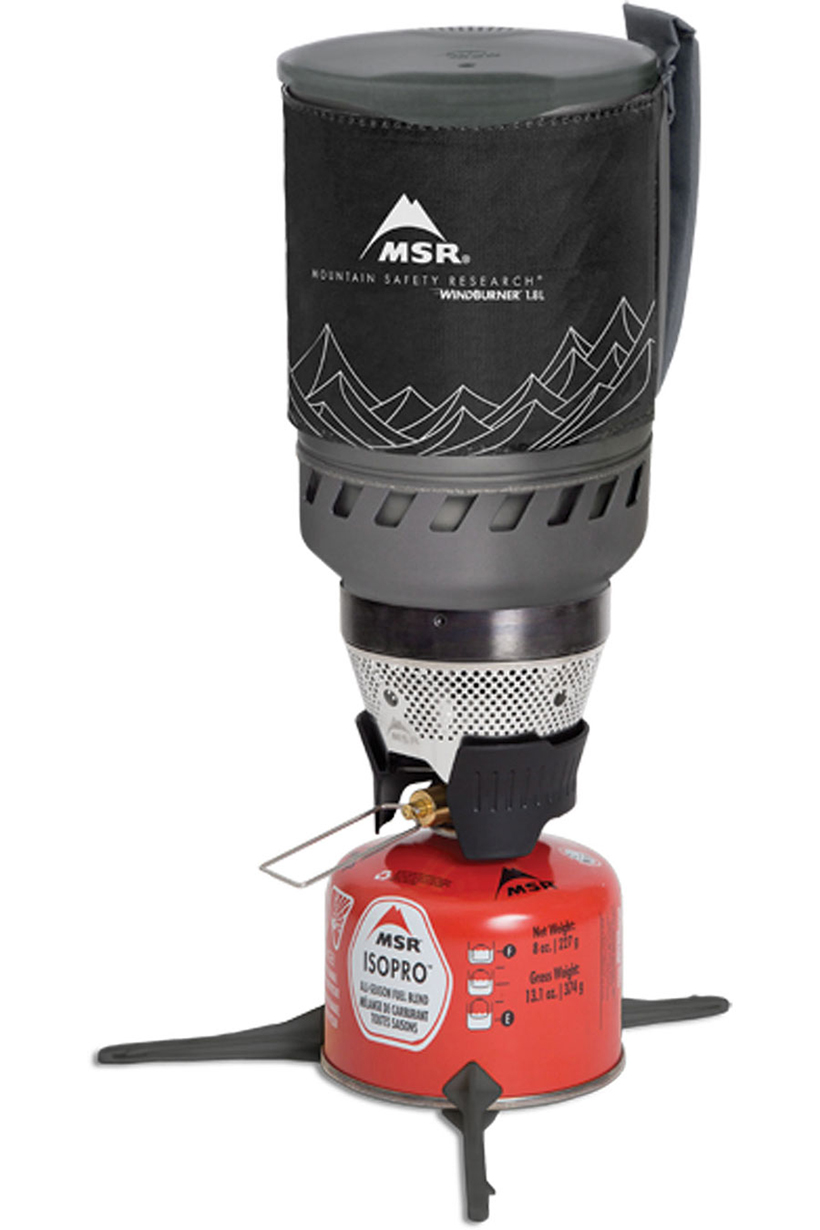
MSR WindBurner
Size Tested: 1.8 L (1.0 L also available)
Stated Weight: 540 grams / 19 oz
Measured Dimensions (all contents packed inside pot): 7.625” tall and 5” in diameter
Stated Features
- Lid with Drinking and Straining Ports
- Insulated Cozy with Handle
- 1.8 L Pot with Heat Exchanger
- Secure Connection with Stove
- Ultra-Efficient Radiant Burner
- Pressure Regulator for Consistent Performance
- Full-Size Bowl: 16 oz. / .47 L
- Folding Canister Stand
MSRP: $159.95 ($139.95 for 1.0 L version)
Test Locations: Rocky Mountain National Park, Salida, & Independence Pass, CO; Spearfish Canyon, SD; Mt Rainier National Park, WA.
Days Tested: 12
Intro
What do you need most out of a backcountry stove? Are you looking to boil water as fast as possible, or do you need precise heat control for more complex meals? How important is efficiency in the wind? Is price a major factor? Such questions are central to identifying the right stove, and MSR’s WindBurner is the most recent addition to MSR’s robust line of backcountry-ready canister stoves.
Originally released a couple years ago under the name “Windboiler,” the WindBurner draws on many of the successful design elements of MSR’s Reactor, while introducing a few modifications to create a more versatile cooking system.
But the WindBurner’s design is also similar to a number of Jetboil stoves, so a primary goal of this review will be to explain the pros and cons of several of these stoves, and to help you decide which is the best fit for you.
Design Overview
As with most canister stoves, the WindBurner is a three-part totem pole comprised of a heating element that screws on top of a disposable fuel canister, and a pot situated just above the heating element.
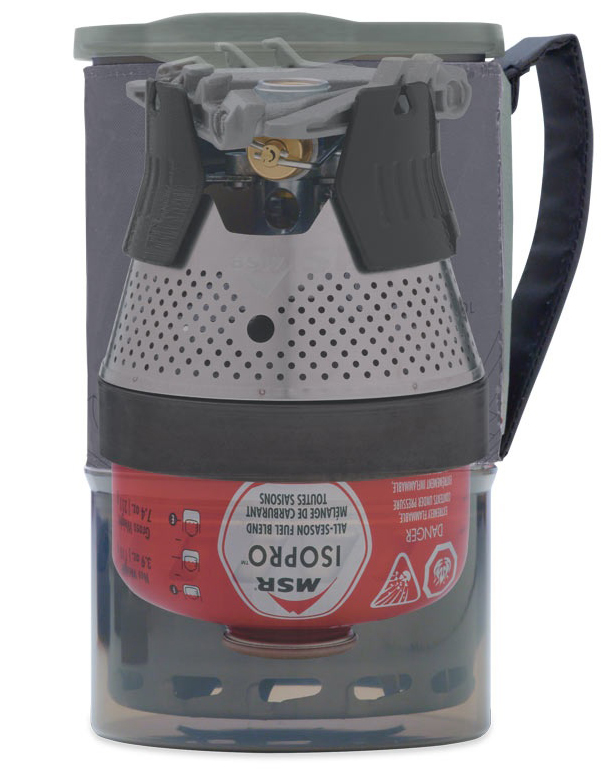
The heating element on the WindBurner is a close relative of the one found in the Reactor; both employ what MSR calls their “heat exchanger,” rather than the open flame found on almost all other canister stoves (such as MSR’s Pocketrocket & Superfly, or Jetboil’s Flash & Sumo lines).
The “open flame” model works just like your gas stovetop at home; fuel is ignited, and the resulting flame contacts the bottom of the pot or pan you are using.
By contrast, the heat exchanger found on the Reactor and WindBurner takes the flame and fully contains it within a metal casing on the bottom and sides, capped by layers of progressively finer metal mesh. The heat, then, comes up through the mesh to the pot rather than contacting it directly. This design accomplishes a couple things:
First, it disperses the heat across the heating element’s entire dome, and also allows some thermal energy that would otherwise be lost to convective thermal transfer inefficiencies to be captured by the mesh and transmitted radiatively to the pot. This boosts the rate of heat transfer relative to an open flame, and improves the overall efficiency of the stove.
Because of their specialized heating elements, the WindBurner and Reactor (especially the latter) are powerful stoves meant primarily for rapidly boiling water. So while you do get some more efficient heat distribution, using these MSR stoves isn’t like using a heavy-bottomed copper pot on your stovetop at home — you have to be careful when trying to simmer (and to this point, I personally avoid the concept of “simmering” altogether with the Reactor).
The second benefit to the heat exchanger is that it helps keep the flame from getting blown out in windy conditions. Maintaining a boil in windy conditions is something the Reactor has excelled at for years.
With the WindBurner, MSR has taken their encapsulated flame design and bolstered the casing around the flame to make it even more robust in blustery conditions. This is the principal achievement of the WindBurner — not only have I never had the WindBurner go out in gusty conditions, but I have tried as hard as I can to blow out the flame and I have never succeeded. As a result, the only real problem high winds pose to the WindBurner comes from the top-heavy vertical design — it can still be knocked over.
In order to make this protective housing of the WindBurner viable, MSR dialed down the thermal output of the WindBurner relative to the Reactor. While the overall anatomy is the same, the Reactor puts out slightly more thermal power than the WindBurner. I had noticed a slightly longer boil time with the WindBurner than I had experienced previously with the Reactor, and MSR confirmed this when I spoke with them. Further evidence of this is the fact that MSR has released a small pan for use with the WindBurner, which is an impossibility for the Reactor because the heat from it is too intense and concentrated in the middle of the pan to heat evenly across a pan’s surface.
Boil Times (and Comparisons)
As I just mentioned, the slightly lower power on the WindBurner shows up in the boil times: I recorded a 4:25 time to bring 1 L of cold stream water to a boil, which is about 25-30 seconds longer than the Reactor. The half-liter boil times were just past 2 minutes, which is right in range with what I’ve experienced with the Jetboil Minimo and Sol Ti.
Although it increases boil time, the slightly lower heat output of the WindBurner makes it much more capable of achieving a simmer than the Reactor; the latter (MSR will gladly tell you) is really only meant for getting water to a boil as fast and efficiently as possible. Although boiling water for coffee or dehydrated food comprises most of my backcountry cooking, it’s still nice to have the ability to cook solid food without scorching it. (When I’m car camping, I use a standard two-burner Coleman stove to cook vegetables, group meals, etc.) So the WindBurner is an improvement over both the Reactor and Jetboil’s Flash in this regard but it doesn’t quite match the precise simmer control of the Jetboil Minimo.
Other Features, Bells, and Whistles
In designing the WindBurner, MSR clearly set out to capture the best features from the Reactor and Jetboil concepts while also addressing some of the minor gripes about each.
For example, because the flame is out of view for the Reactor and WindBurner, it isn’t immediately clear that the stove is lit during daylight. You can feel the heat coming off the stove, and eventually the wire mesh turns red. But it’s not always clear whether the stove is actually lit.
The WindBurner’s fix to this is the addition of a very thin metal wire stretched across the side of the heating element that begins glowing red almost immediately upon lighting:
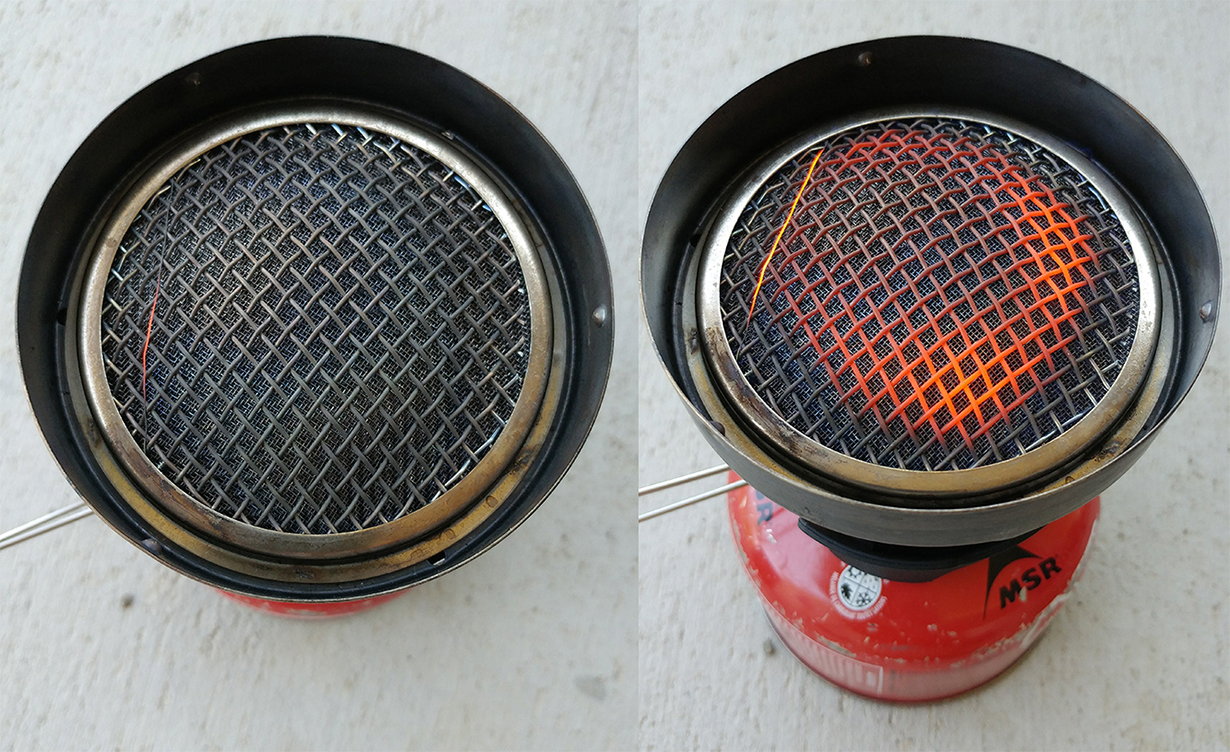
So now, you don’t have to choose between waiting a minute for the whole fixture to heat up or risk burning your hand near a hot stove to figure out whether it is indeed lit. This is a very small problem, sure, but MSR has provided a very clever, low-tech fix.
Another improvement with the WindBurner is that its pot screws onto the heating element rather than just resting on top. This is similar to Jetboil’s design, but the WindBurner improves upon the concept slightly. Jetboil stoves (like the Flash or Minimo), have three dimples on the pot with corresponding slots on the heating element to accept them. The WindBurner has fourteen, which makes attaching the two components a less visual process as you don’t have to be quite as precise when lining up the slots. This is another extremely minor difference in terms of user experience, but it is a nice improvement.
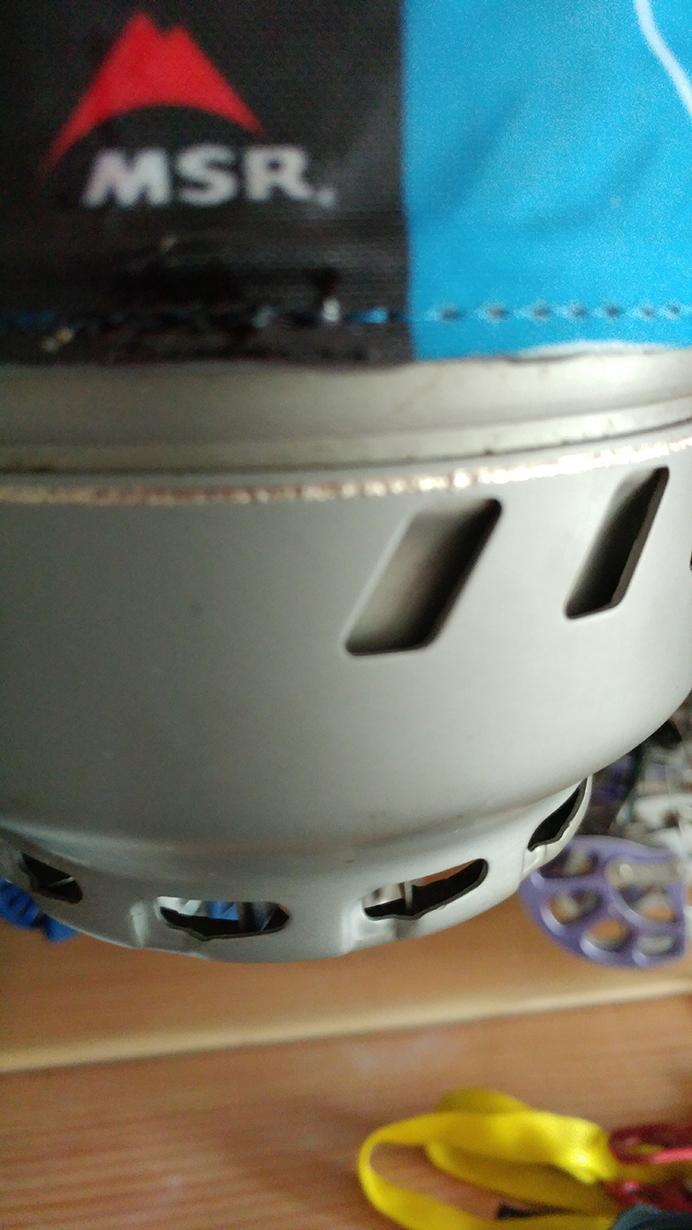
A much more consequential factor here is that once the water is boiling and the metal is hot, the screw-on attachment process on the Jetboil stoves is suddenly hard to reverse, and it’s difficult to separate the pot from the stove unit. It only requires a moderate amount of twisting to loosen the pot, but when said pot is filled with water just off the boil, this can feel like a dangerous high-wire stunt — made even more consequential if you’re in a tent or on a portaledge, which is a lesson I’ve learned and re-learned the hardest possible way with other stoves in the past.
The pot on the WindBurner, for whatever reason, doesn’t have that same thermal expansion snag, and can be easily lifted off with one hand. Additionally, the neoprene sleeve on the WindBurner is a little more robust and confidence-inspiring than the one found on the Jetboil Flash, though it’s not as sturdy as the rigid handles found on the Jetboil Minimo.
One of the changes I didn’t love with the WindBurner was the plastic tripod stand that fits under the fuel canister to stabilize the stove system. The Jetboil version consists of one solid plastic piece that snaps onto the canister. The WindBurner version uses three plastic legs with an elastic band connecting them, so the stand is meant to be stretched over the canister. This definitely makes it lighter and more packable, but it’s much more of a pain to put on. It’s a good thought and the packability is nice, but it’s not worth the annoyance of taking it on and off.
I also tested the french press accessory for the WindBurner, which is very similar to the french presses for the Reactor and Jetboil stoves. All share a similar construction that consists of a metal screen with a plastic ring (or rubber in the case of the Reactor) around the sides to prevent the screen from scratching the metal pot.
As a result, these stoves’ french presses aren’t quite as effective at filtering the grounds compared to a regular french press that lacks the plastic/rubber ring (particularly if you use a finer grind). The Reactor’s press does a slightly better job, but this issue can be alleviated in all the stoves by using a coarser grind (even household french presses typically recommend a coarse grind for this exact reason).
Price
This is a key differentiator between all these stoves, and will likely be the deciding factor for many would-be backcountry chefs / coffee addicts. One of, if not the primary downside of the Reactor is its ~$200 price tag. On the other end of the spectrum, the Jetboil Flash owes part of its runaway success to its more modest $100 price point. The WindBurner (in the 1.0 L size) is $140, making it much more accessible than the Reactor, and closely in line with the Jetboil Minimo that retails for $135.
So, Which Should You Get?
All this discussion of features can be distilled down to one simple question: why consider the WindBurner over either the Reactor or one of Jetboil’s stoves? In large part, this really depends on your priorities. The Reactor is definitely the best option if you primarily want to boil water as fast and efficiently as possible, and price is no object. You fall into this category if, for example, you are looking to do some bigger-mountain adventuring, and you want your fuel to last as long as possible.
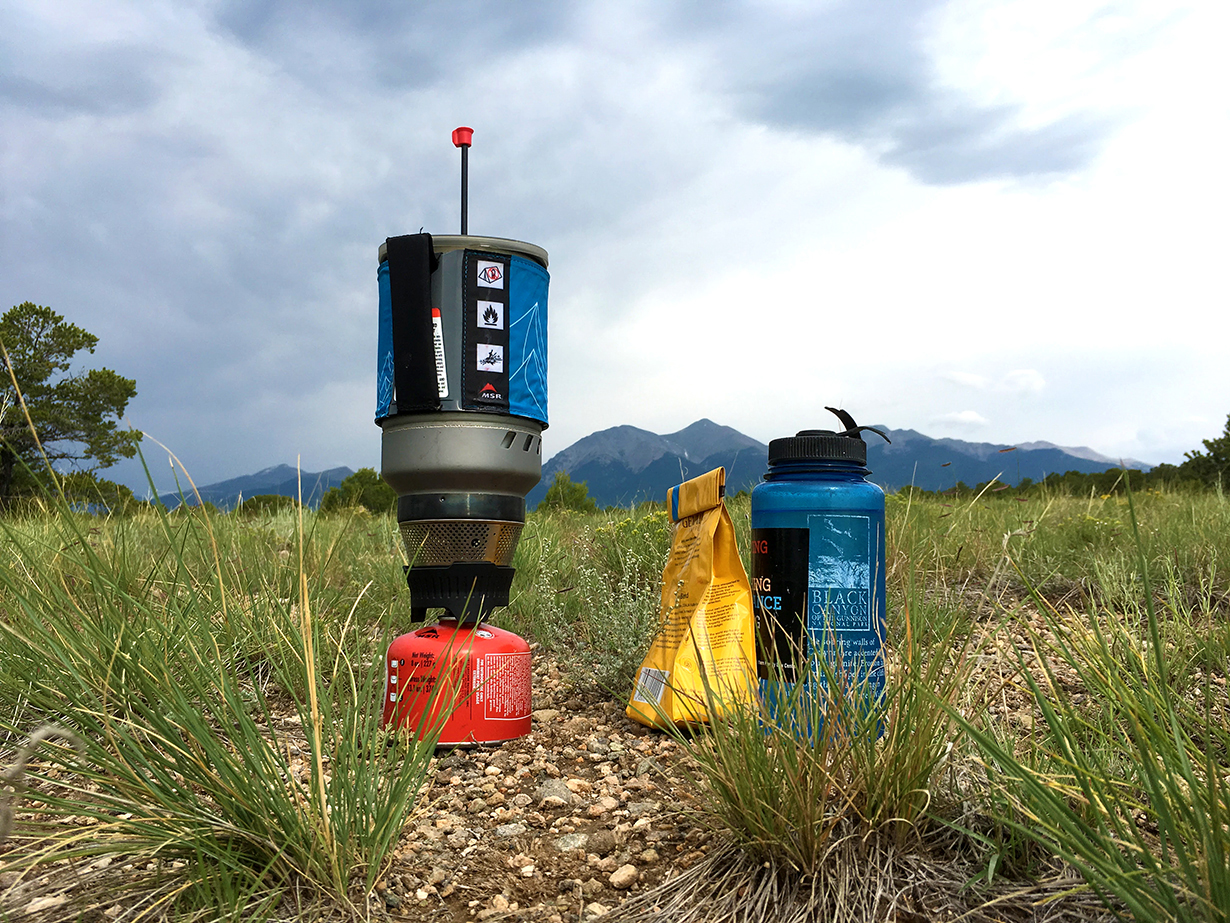
When price is a factor or you’re looking for a more versatile stove (say, one that might be coaxed into a simmer), then either the WindBurner or Minimo are probably your front-runners. Between these two, I give the edge to the WindBurner because of its superior wind resistance and its collection of features / upgrades that I mentioned earlier. All of these stoves perform the central function of boiling water with a convenient, packable design well enough, so if cost is the central consideration, the Jetboil Flash is fully capable and significantly cheaper than the others.
Bottom Line
MSR’s WindBurner stove retains some of the technical features of the MSR Reactor that make it efficient and extremely wind resistant, while incorporating some of the convenience and versatility that has propelled Jetboil to widespread success. Just on the merits of this combination of features, the WindBurner is a great stove. And when the price is factored into the equation, the WindBurner might be the best canister stove currently on the market.
